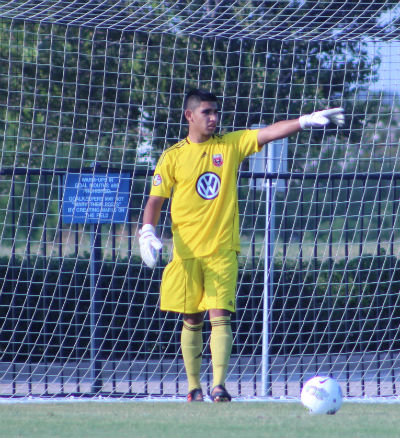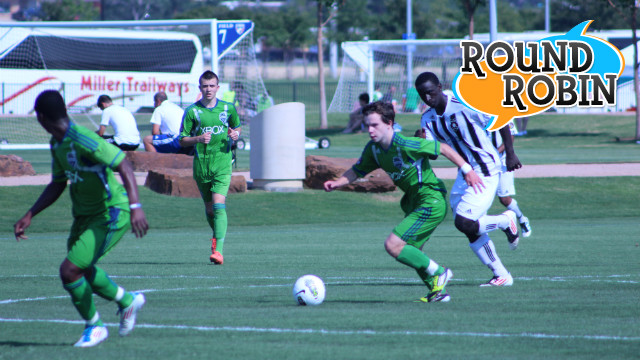 Academy players have big decisions to make.
Academy players have big decisions to make.Is a 10-month Academy season the right move?

Welcome to the Wednesday, July 11 edition of the TopDrawerSoccer.com Round Robin, where our editorial staff members weigh in on important topics in the world of American soccer. Please note that each opinion expressed is that of the author giving them, and not necessarily editorial policy at TopDrawerSoccer.com.
Today’s Topic: Academy vs. High School. So USSF’s Development Academy will soon begin its 6th season,and this time around it is a 10-month slate for everyone, meaning none of the Academy players will participate in high school soccer. In recent days we’ve run articles on the fortunes at the DA Playoffs of teams already going year-round and an overview of the DA’s success rate thus far. The debate on the policy move continues around the country as the fundamental question remains, and so we ask again:
Is the decision to put at least 4,000 players nationally and remove them from scholastic sports the right call for USSF?
Travis Clark: It's the right move to make this decision. But there are several caveats to consider. Kids need to be tested at the highest level and get games. But what happens when a player isn't given time on his Academy team and isn't allowed to play high school? Perhaps there can be some sort of considerations given to those players, afforded a chance to train at times with his academy and play high school soccer if he's on the fringe. Because there are certainly past be cases of players improving on their respective high school teams even though the competition that might not be as high of a level.
That concern aside, if this allows for another day of training per week, it can only be an improvement over past standards.
 Academy players have big decisions to make.
Academy players have big decisions to make.J.R. Eskilson: Is it the right call? Yes. Is now the right time to do it? Probably not. Let me explain. It is my belief that U.S. Soccer is taking the right path to improving player development by using a model that has the players training and playing competitive games for 10 months. However, I do not believe the Development Academy is evolved enough to really take advantage of such a situation. I believe there are other areas where USSF, the academies, and coaches could improve the quality of the play and player before broaching the subject of scholastic sports. I'd rather see Claudio Reyna, Tony Lepore, and the rest of the technical advisors of the Development Academy really take a hands on approach with the training, style of play, and accountability for the clubs first [something beyond the star rating system that was just implemented]. As explained earlier, the Academy is still in its infancy with only five years of history. There are many years ahead for the Academy. There was no reason to rush into something that has made so many enemies for USSF before the rest of the Academy was really at the level to justify the move.
Caroline Yort: I'm not entirely sure how I feel about this one. High school soccer can be incredibly rewarding for a player who doesn't always get positive motivation in the Academy system (and even for those who do). For those that are on an Academy team, but don't typically get invited to market training, or don't get a lot of playing time on the team, or receive recognition other than simply making the team, high school soccer can remind teenagers that they really are good, and can give them the positive mindset necessary to make it through the grind and the sacrifice of the long Academy season. For those players, the high school season gives them the playing time they lack in Academy (subbing in at the 88th minute should not count as a game played in the Academy system, and starting and playing 10 minutes should not count as a start, either). In the bigger cities, there are typically several Academy players on each high school team, and almost all of those that make a high school team these days play select soccer in one form or another, so although training is less competitive, that doesn't mean it is NON-competitive. And with training and games Monday through Friday, sometimes the players are actually in better shape coming off of high school than Academy (training 3-4 days a week and maybe or maybe not playing on the weekend).
On the other hand, if the aim of US Soccer is to produce a national team capable of making it past the knock-out rounds in a World Cup, then the training has to be extremely consistent and challenging, much like youth clubs in other countries. Like in many other sports, training to be the best isn't always fun. And it's the kids who remain dedicated and in the Academy, despite the sacrifices, that win in the end.
Robert Ziegler: It all comes down to the difference between “Pretty Good” and “Really Good.” Our society has become keen on everyone getting some form of accolade or another. I have no problem with everyone getting a chance to compete at a certain level, but the tendency is to drag the players in the best tier, unwittingly or not, into the next lowest tier for the sake of some kind of egalitarian nirvana. None of that helps us build up the “Really Good” class of player. To me it is like a boxer or wrestler wanting to compete 2 or 3 weight classes below his actual weight.
It may be that this mandate will serve to reduce the sizes of Academy teams, and I have no problem with that. The original idea was to combine two age groups for each age group team in the Academy, although U.S. Soccer has continued to allow teams to basically make their two Academy teams U18 and U17. I think 17-20 players is a better roster size and let’s not pretend that there are 30 players per team at 80 or so clubs who are potential professionals. This would prevent the charade Caroline mentions about fulfilling playing time requirements through late subs or early hooks for fringe players on the roster in Academy games. Then the players who don’t have those professional aspirations (or that talent) can enjoy their scholastic experience along with a lower level of club soccer and with it gobble up all the recognition they could ever want.
Travis Clark's Final Word: This debate can go on and on surely, and it's hard to know what is the right decision. But U.S. Soccer has made its decision, leaving high schools players good enough for Academy soccer this fall with a big decision to make. And there's no question that the stakes are going to be high - if players decide they'd rather play high school than the Academy, they put themselves at risk of not catching the eyes of college coaches.
For the sake of U.S. Soccer, let's hope that this is the right move, as it is arguably the biggest move made by the Federation at a development level. There's only one thing observers of the game can do - sit back and see wat happens.
Headlines
- Recruiting Roundup: July 14-20
- 2025 Women's Division I Transfer Tracker
- How Do I Get Scouted by TopDrawerSoccer?
-
ECNL Girls Finals U16 Preview

- North American Soccer Expo Launches
- ECNL Boys Finals Under- 15 Preview
-
Commitments: Striker Set on MSU

- IMG Academy Player Rankings: Girls 2028
-
ECNL Girls Finals U15 Preview

-
ECNL Boys Under-16 Finals Preview




